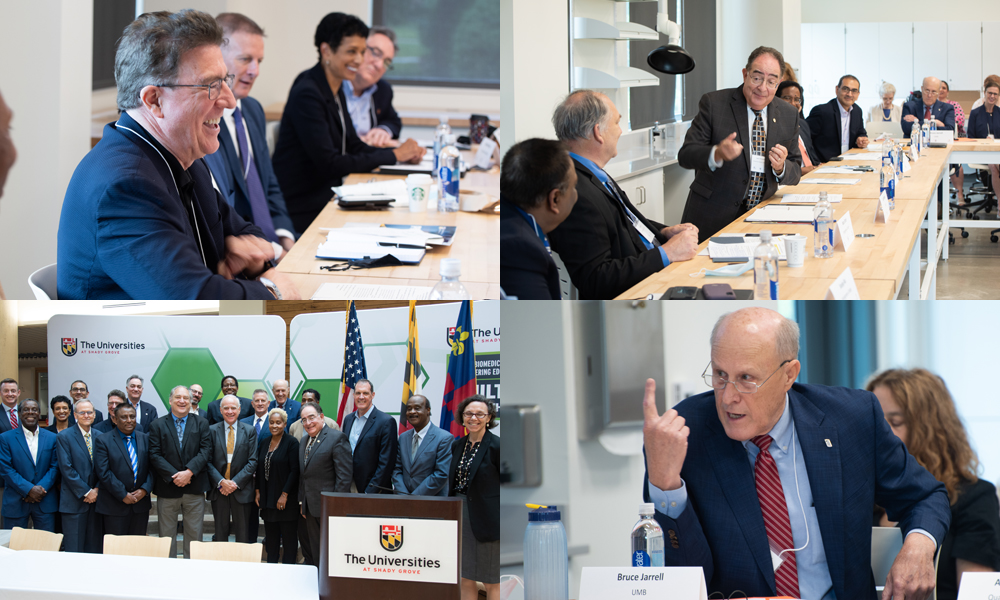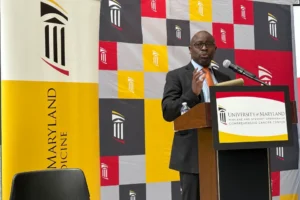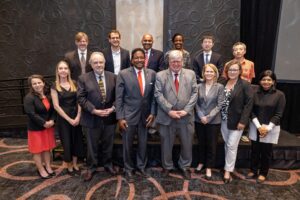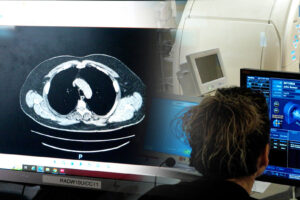Partnership to Promote Education and Innovation
Published 6/14/21 on UMB News
“You will see the word partnership repeated throughout this document,” said Isiah “Ike” Leggett, JD, University System of Maryland (USM) regent and former Montgomery County executive to a room filled with leaders from government, higher education, and life science businesses. The document he held in his right hand was the reason for the June 11 meeting on the campus of the Universities at Shady Grove (USG) in Rockville. All gathered for the signing of a memorandum of understanding outlining a strategic alliance designed to greatly enhance opportunities for students, propel further innovation, and provide a talent pipeline for the region’s burgeoning life sciences industry — the Maryland Life Sciences Education and Innovation Partnership.
“This does not work without partnership. It will take time for us to fully execute this, but we have a movement, we have a plan, we have the right people in the room where it happens,” he continued, making a reference to the musical Hamilton.

Those “people in the room” included USM Chancellor Jay A. Perman, MD, the presidents and other representatives of five USM institutions and Montgomery College, Montgomery County Executive Marc Elrich, and business leaders from AstraZeneca, IBM, S3, American Gene Technologies, Quality Biological, and US Pharmacopeia.
“Partnership is a key thing for success, especially in Maryland with the system for us to develop linkages across the various institutions,” agreed Karl V. Steiner, PhD, vice president for research at the University of Maryland, Baltimore County, nodding to Bowie State University President Aminta H. Breaux, PhD, seated nearby. “I think there’s a power in working together, really showing the power of USM, which the chancellor has really challenged us to do.”
The University of Maryland Strategic Partnership: MPowering the State, which combines the research activities of the University of Maryland, Baltimore (UMB) and the University of Maryland, College Park (UMCP), is a great example of the power of partnership, explained UMB President Bruce E. Jarrell, MD, FACS. “As I told President Pines just a few minutes ago, one of the most difficult things I’ve had adjusting to being the president, is that among public universities, we’re ranked eighth in research. And I go, my gosh, think about that,” Jarrell exclaimed. “Our combined research expenditures are over $1 billion per year, which is a large amount of money. So, there is tremendous research expertise sitting on these two campuses, as well as throughout Maryland and in the biotech community.”
But unlike MPower, the Maryland Life Sciences Education and Innovation Partnership goes a step further, bringing the educational and research aspects of Maryland’s public higher education institutions into a close working relationship with industry. The goals are to provide Maryland students richer experiential learning, and Maryland biotech businesses a highly qualified pool of talent.
Key elements of the partnership are a commitment to collaborate to enhance student career path awareness and inform the development of curricula and programmatic offerings that support industry’s workforce needs, and to establish postgraduate research programming that will focus on future aspects, needs, and opportunities fueled by the life sciences industry, with the goal of ensuring that Maryland remains a premier location for biotech industry advancement.
To ensure that future, industry could use some help engaging and informing students, and raising the caliber of talent, said Joe Sanchez, PhD, MBA, director of R&D science engagement at AstraZeneca. “It’s not enough to just teach the talent, we can expose them. We have to solve that chicken and egg problem: We can’t get the job without the experience, you can’t get experience without the job,” he said. “Again, making sure there’s a new balance between formal education in the classroom, and then doing the job.”
“I love the idea of the intellectual capital,” added Jeff Galvin, CEO and founder of American Gene Technologies. “What’s coming in the future, who knows? If you tell them what to think, or what to learn, they’re prepared for today. And that’s it. If you teach them how to think and how they’re prepared for the future, and we are prepared to grab every single one of those minds that you can create.”
“We need academic programs created through partnerships,” said Sanjay Rai, PhD, senior vice president for academic affairs at Montgomery College, “partnerships with Montgomery College, partnerships with USM institutions, and partnerships with industry.”
Following a group discussion, key stakeholders reconvened in the sweeping atrium of USG’s Biomedical Sciences and Engineering Building to put pens to paper.
“The big winners with this announcement today are the students and researchers at all these institutions, the industry leaders who are seeking to employ these students, and to connect on cutting-edge research,” said Elrich. “This industry accounts for 40,000 life science workers, and 63,000 STEM workers in the county. With the continued growth and support from the county, these academic institutions, we are laying the foundation for us to continue to grow.”
“You know, this can be, if you will, America’s biotech heartbeat,” added Perman. ”We have the federal labs agencies in our own backyard, a long track record, collectively, of winning transformational federal grants and contracts. In our students and our graduates, we have the challenge. That power is one of the country’s most productive innovation economies. Year in and year out, Maryland ranks among the top three best-educated states among the most innovative states, the most entrepreneurial states. And if that’s good, this MOU makes it better, because it brings a framework to the work to leverage our individual strengths for collective benefits.”



